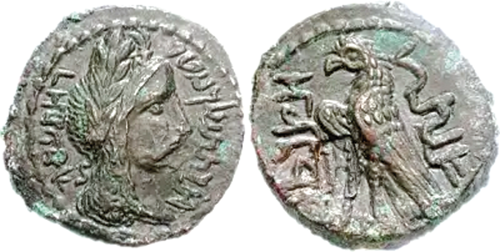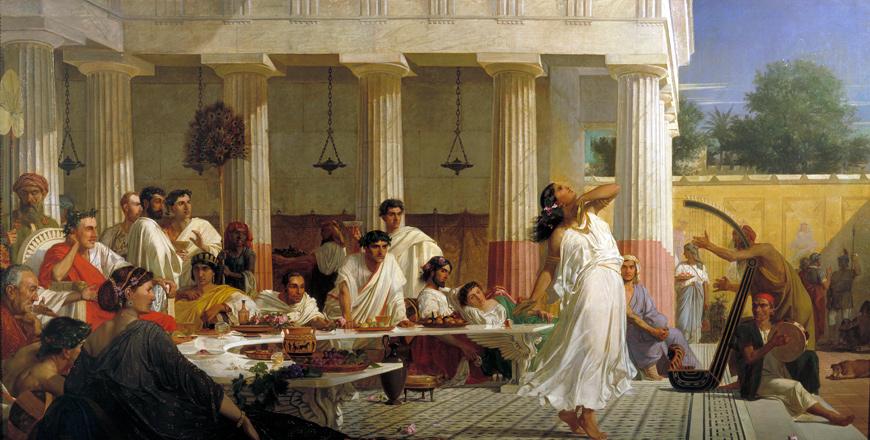You are here
Nabataean kings’ coins defy Roman influence, show 'unique' independence
By Saeb Rawashdeh - Oct 28,2024 - Last updated at Oct 28,2024

Laureate head of Aretas right with Nabatean legend 'Aretas, King of the Nabateans, lover of his people' on a silver coin (Photo courtesy of Nabataea)
AMMAN – The Roman style was popular among the ruling elites in the client states of the Roman Republic and later the Roman Empire. However, on their coinage, the Nabataean rulers did not broadcast the Roman imperial imagery, unlike the Herods where the Roman elements are obvious.
Coins of Herodian kings routinely bear the busts of emperors on their obverses. Agrippa I (41 AD–44 AD) even copied Roman imperial dies, such as a famous Roman sestertius type with Caligula on the obverse and the emperor’s three sisters
"Other issues co-commemorate Caligula’s father Germanicus, depicted in a triumphal quadriga. Since the days of Herod the Great, Herodian rulers made every effort to present themselves as models of loyalty and an integral part of the Roman Empire," said Professor Andreas Kroop from the University of Nottingham.
The only Greek letters on Nabataean coins are Greek numerals on two of the earliest issues of the Petra mint, the coins of Malichus of the 30 BC. There is no allusion to Rome in either text or image, and not so much as a hint of even the existence of the Roman Empire.
The images on the Nabataean coins had a different approach towards the Roman political power, although Judea and Nabataea were in a similar position to the Roman state.
"There was no juridical status of 'client kingship' – each king had to rely on his connections and intuition to figure out what, if anything, the emperor would have him do," Kropp said, adding that in political terms, the Nabataean kings remained relatively independent-minded.
Aretas IV ruled without much of the Roman interference in the Nabataean internal issues. When Obodas II died in 9 BC, Aretas IV seized the throne in what some considered an old coup d’état, Kropp continued, adding that the following scuffles are well documented and require no detailed analysis.
"Aretas withstood the grudge and distrust of Augustus and the defamations by Obodas’ former minister Syllaeus at the imperial court in Rome until, for lack of alternatives, Augustus confirmed Aretas 'with no great enthusiasm for the king himself'. Aretas took an opportunity to prove his usefulness to Rome in the civil strife in Judaea that ensued in the wake of Herod’s death in 4 BC, by sending a large contingent of troops to support the Roman governor of Syria Quinctilius Varus," Kropp said.
He added that it appears that the king’s rapports with Rome remained strained, though it is rather unlikely, as some suggest, that relations declined to such a point that Augustus temporarily withdrew the kingdom from Aretas and created an ephemeral provincial Arabia between 3–1 BC.
Furthermore, towards the end of his long reign, Aretas IV waged wars with neighbouring states which Romans found annoying.
Rome sided with the Herodian king, and Vitellius was set to invade and conquer Arabia when timely news arrived of the death of Tiberius in 37 AD. In the following decades, the Nabataean kings Malichus II and Rabbel II managed to maintain their independence thanks to diplomatic and military skill, and they held out longer than any of their rivals.
Kropp continued: "Before further analysing the royal imagery, and the extent to which the exceptional set of historical circumstances help explain Aretas’ adoption of the laurel wreath, it is worth citing the only textual source that gives a description of a Nabataean king and his court. It too reveals fundamental differences from the Herodians and other comparable dynasties."
The eyewitness Athenodoros, as reported by Strabo, notes with astonishment the king’s lack of pomp and ceremony. "They [the Nabataeans] go out without tunics [akhitonos], with girdles about their loins, and with slippers on their feet – even the kings, though in their case the colour is purple".
Even more surprising to the Greek observer was the king’s behaviour as a "man of the people" serving his guests in person at symposia.
Aretas IV had strained relations with the Roman Emperor Augustus and the choice of the laurel wreath as royal insignia seems entirely out of tune. However, the model for this innovation is unlikely to have come from the Greek world. Laurel had mainly been associated with Apollo and with victory at games and contests, but had not been used as insignia of power.
"Hellenistic kings likewise rarely swapped their diadem for the laurel wreath. By contrast, in the Roman world the laurel wreath was an attribute charged with political significance, as literary sources amply attest," Kropp said.
According to recent research, the coins with laureate heads, which are notoriously hard to date due to the lack of external evidence, go further back in time than originally thought, up to perhaps the beginning of the 1st century BC.
There are, besides, also later series that depict what has been identified as the portrait of Augustus laureate and it is remarkable to find the Roman emperor on the coins of rulers outside his reach, whereas those within his orbit, the Nabataeans, never depicted him or any other emperor on coins, the historian underlined.
Related Articles
AMMAN — The style of the Nabataean kings had been influenced by Graeco-Roman political and cultural models.
AMMAN — For decades, scholars have linked the biblical tradition about the beheading of John the Baptist with the material evidence found at
AMMAN — Prior to 1968, the hilltop of Machaerus, overlooking the Dead Sea near Mount Nebo was an untouched “virgin” site, according to Hunga


















